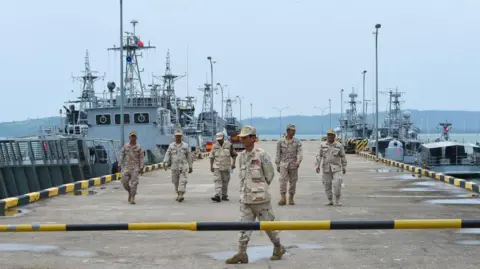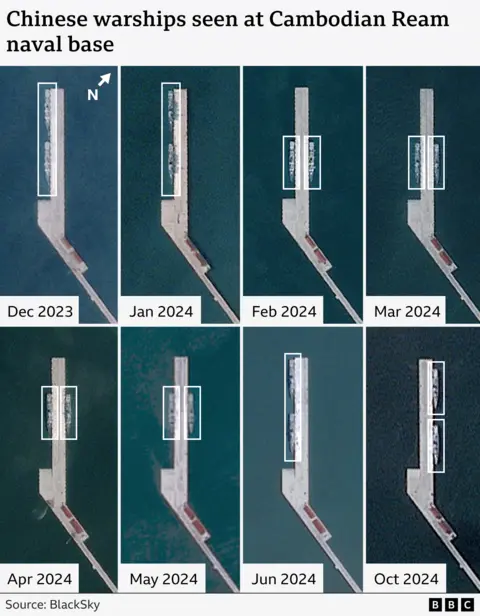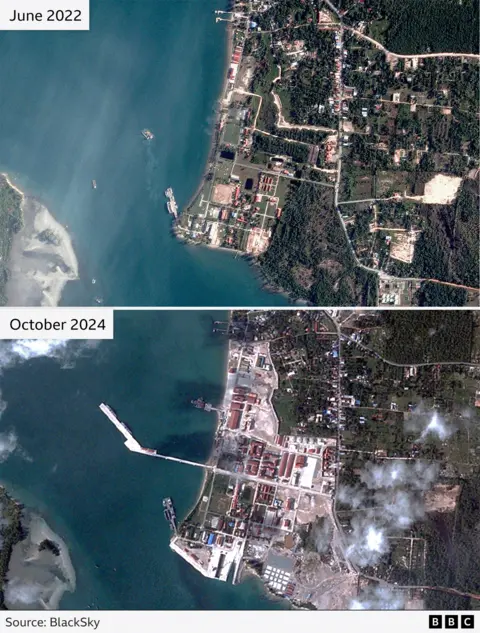Does China now have a permanent military base in Cambodia?
 Getty Images
Getty ImagesTwo grey shapes, visible from satellites for most of this year at Cambodia’s Ream naval base, seem to confirm growing fears in Washington: that China is expanding its military footprint, beyond the three disputed islands in the South China Sea which it has already seized and fortified.
The shapes are type 056A corvettes of the Chinese navy - 1,500-tonne warships - and they have been berthed alongside a new, Chinese-built pier that is big enough to accommodate much larger vessels. Onshore there are other facilities, also built by China, which are presumed to be for the use of the Chinese navy.
The Cambodian government has repeatedly denied such a possibility, citing its constitution which bans any permanent foreign military presence, and stating that Ream is open to use by all friendly navies.
"Please understand this is a Cambodian, not a Chinese base," said Seun Sam, a Policy Analyst at the Royal Academy of Cambodia. "Cambodia is very small, and our military capacities are limited.
"We need more training from outside friends, especially from China."
Others, however, are watching with suspicion.

For all the talk about the rapid rise of Chinese sea power - the country now has more ships in its navy than the US - China currently has only one overseas military base, in the African state of Djibouti, which it built in 2016.
The United States, by contrast, has around 750 - one also in Djibouti, and many others in countries close to China like Japan and South Korea.
The US believes the imbalance is changing, however, because of China’s stated ambition to be a global military power. That, and the scale of its investments in overseas infrastructure through the Belt and Road Initiative, which under Chinese law must be built to military standards.
Some in Washington predict that China will eventually have a global network of bases, or civilian ports that it can use as bases. And one of the first of these is Ream.
Warming ties
Until a few years ago, Ream - which sits on Cambodia's southern tip - was being upgraded with US assistance; part of the tens of millions of dollars' worth of yearly military aid provided to Cambodia. But the US cut back this aid after 2017, when Cambodia's main opposition party was banned and its leaders exiled or jailed.
Already increasingly dependent on Chinese aid and investment, the Cambodian government abruptly switched partners. It cancelled the regular joint military exercises held with the US, and switched to the so-called Golden Dragon exercises it now holds with China.
By 2020, two US-funded buildings in Ream had been torn down and an extensive, Chinese-funded expansion of the facilities there had begun. By the end of last year the new pier had been built. It was almost identical to the 363 metre-long pier at the base in Djibouti, and long enough to accommodate China’s largest aircraft carrier.
Soon the two corvettes were docked at Ream - and either they, or identical replacements, have stayed there for most of this year.
Cambodia claims the ships are for training, and to prepare for this year’s Golden Dragon exercises. It also says China is constructing two new 056A corvettes for its own navy, and insists that the Chinese presence in Ream is not permanent, so does not count as a base.
That has not stopped US officials from expressing their concern over the expansion of the site, though, which satellite photographs show has, in addition to the new pier, a new dry dock, warehouses, and what look like administrative offices and living quarters with four basketball courts.

In 2019 the Wall Street Journal reported on what it said was a leaked agreement between Cambodia and China to lease 77 hectares of the base for 30 years. This allegedly included the stationing of military personnel and weapons.
The Cambodian government dismissed the report as fake news - but it is noteworthy that only Chinese warships have so far been allowed to dock at the new pier. Two Japanese destroyers visiting in February were instead told to dock at the nearby town of Sihanoukville.
Even if the Chinese presence does start to become more permanent and exclusive, however, some analysts doubt it would violate Cambodia’s constitution.
It is technically true that Ream is not a permanent base. And while its expansion is Chinese-funded, the base itself is not leased to China, said Kirsten Gunness, a Senior Policy Researcher at the California-based Rand Corporation.
“We are seeing a pattern of Chinese ships being continuously docked [at Ream]," she said. "One way to get around the constitutional prohibition is not to call it a foreign base, but allow foreign forces continuous access on a rotational basis."
The US and the Philippines operate under similar agreements, Gunness added.
Fears next door
Most analysts believe a long-term Chinese presence at Ream would offer very few real advantages to China. They point to the three bases it has already built on Mischief, Fiery Cross and Subi Reefs in the South China Sea, and the formidable naval forces it maintains on its south coast.
But a Chinese base in Ream, at the mouth of the Gulf of Thailand, does worry Cambodia’s neighbours, Thailand and Vietnam. Together with other bases further north, it could be seen as an attempt by China to encircle the long Vietnamese coast.
Like the Philippines, Vietnam disputes China’s claim to almost all the islands in the South China Sea, and its forces have clashed with China’s in the past.
Thai national security officials have also privately expressed alarm at the thought of a Chinese base just south of the Thai navy’s main port in Sattahip, covering their exit from the Gulf of Thailand. Thailand and Cambodia still have unresolved territorial disputes, after all.
 Getty Images
Getty ImagesNeither country is likely to voice these complaints publicly, though. Thailand will want to avoid causing ripples in its economically vital relationship with China, while Vietnam will want to avoid stirring up anti-Vietnamese sentiment in Cambodia. Public resentment of China in Vietnam, where such feelings are never far from the surface, is also something the Vietnamese government will want to steer clear of.
US and Indian strategists, meanwhile, are more concerned about the future possibility of a Chinese base in the Indian Ocean – like the Sri Lankan port of Hambantota, which a Chinese state-owned company acquired a 99-year lease for in 2017, or the port of Gwadar in Pakistan, which has also been redeveloped with Chinese funding.
But these are still very distant prospects. Few analysts believe China will be able to rival the global military reach of the US for many more years.
"The Ream base does not add much in the way of power projection - it doesn’t get the Chinese navy any closer to places it wants to go," said Greg Poling, director of the CSIS Asia Maritime Transparency Initiative.
What it could do is make a big difference in gathering intelligence, tracking satellites and detecting or monitoring long-range targets.
"These are not necessarily the best options for China," Mr Poling added. "But they are the only ones on offer."
